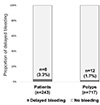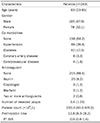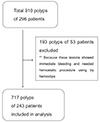Abstract
Background/Aims
Bleeding is one of the major complications of a colorectal polypectomy. The aim of this study was to identify the risk of delayed bleeding, particularly after a colorectal endoscopic mucosal resection (EMR) without prophylactic clipping.
Methods
Between April 2014 and August 2014, patients who underwent colorectal EMR (≥6 mm and <2 cm) without prophylactic clipping were included. This study evaluated the incidence of delayed bleeding and the associated factors after colorectal EMR without prophylactic clipping.
Results
A total of 717 colorectal polyps (≥6 mm and <2 cm) of 243 patients resected by colorectal EMR in the study period were evaluated. The mean age of the patients was 63 years; 165 patients were men and 78 patients were women. The mean polyp size removed by colorectal EMR was 9.0 mm (range 6.0–19.0), and the number of polyps larger than 1 cm was 212 (29.6%). Delayed bleeding after colorectal EMR occurred in 12 polyps (1.7%) in eight patients (3.3%), and there were no significant risk factors affecting delayed bleeding.
Colonoscopic polypectomy is useful for reducing the incidence and mortality of colorectal cancer.1 Most colorectal polyps detected during colonoscopy can be removed safely by polypectomy. On the other hand, several complications can occur after colonoscopic polypectomy, which include perforation, hemorrhage, or postpolypectomy electrocoagulation syndrome.2 Postpolypectomy bleeding is the most common complication of a polypectomy, which can be classified by immediate and delayed bleeding.34 These complications can help decrease the compliance performing colonoscopy. Immediate bleeding commonly occurs within a few minutes after a polypectomy, and an epinephrine injection or clipping can control it during colonoscopy.5 Delayed bleeding commonly occurs within 5–7 days after a polypectomy, but it can also occur within a few hours or after 17 days.67 According to recent studies, the rate of immediate bleeding and delayed bleeding has been reported to be 1.5–2.8% and up to 2.0%, respectively.8910
Hayashi11 first reported the use of hemoclips for the treatment of gastrointestinal bleeding in 1975, and Wang et al.12 described the first prophylactic use of hemoclips to prevent delayed bleeding after a polypectomy in 1997. Hemoclips are useful in the management of gastric ulcer bleeding, Mallory-Weiss syndrome, and bleeding of Dieulafoy's lesion,131415 but studies on the effects of prophylactic clipping to prevent delayed bleeding are limited in number and are controversial. Some studies reported that the use of hemoclips is useful for preventing delayed bleeding on large (≥2 cm) pedunculated or sessile polyps,1617 and other studies reported that prophylactic hemoclips placement did not decrease the occurrence of delayed bleeding after colonoscopic polypectomy.1819 Old age, polyps at a right-sided colon, sessile or large (≥2 cm) polyps, hypertension, and the use of anticoagulants are known risk factors for delayed bleeding.3720 Despite these reports, there is little information on the delayed bleeding of polyps (<2 cm) after endoscopic mucosal resection (EMR) without prophylactic clipping.
Regarding the polypectomy technique according to the size of the polyp, although the polypectomy technique for diminutive and small polyps is highly variable among endoscopists, polyps ≥6 mm have been removed using a snare polypectomy including EMR as the technique of choice and diminutive polyps have been removed commonly by cold biopsy forceps.212223
This study suggests that the use of prophylactic hemoclips is not helpful for preventing delayed bleeding of colorectal polyps (≥6 mm and <2 cm) after EMR. In addition, an attempt was made to determine the risk of delayed bleeding after colorectal EMR without prophylactic clipping.
This was an observational study performed in a single center. Between April 2014 and August 2014, patients who underwent colorectal EMR at Kosin University Gospel Hospital in Korea were included. A study investigator (HK) collected the detailed clinical data, including age, gender, presence of comorbidities (hypertension, diabetes mellitus, cardiovascular disease, cerebrovascular disease, and chronic kidney disease), and the use of anticoagulant therapy (e.g., aspirin, clopidogrel, ticlopidin, cilostazole, and warfarin). Patients were instructed to discontinue anticoagulants before the colonoscopy, according to the guidelines.23 Aspirin was continued; clipidogrel or ticlopidin was stopped 5 to 7 days before the colonoscopy and restarted at the day after the procedure. Cilostazole was stopped 2 days before the colonoscopy and restarted at the day after the procedure, and warfarin was stopped 5 days before the colonoscopy and restarted at the evening of the procedure day. Patients who had large (≥2 cm) polyps or diminutive (≤5 mm) polyps detected during colonoscopy, and patients who had bleeding that continued for more than 1 minute after EMR and needed to perform clipping were excluded from the analysis. The Institutional Review Board of Kosin University Gospel Hospital approved this study (KUGH 2019-01-001).
Three experienced endoscopists (JHK, HJK, and YJC) performed all colonoscopies at the endoscopy center of Kosin University Gospel Hospital using an EVIS LUCERA CV-260 colonoscope (Olympus, Tokyo, Japan). During the colonoscopy, the number, size, location, and morphology of all polyps detected were recorded, and EMR removed polyps larger than 6 mm after saline injection. EMR was performed by a snare (crescent type, Finemedix, Daegu, Korea) resection using a combination of an Endocut-Q (effect 2, duration 2, interval 6) and forced coagulation (effect 2, 40 W) current (ERBE VIO300D; Erbe Elektromedizin GmbH, Tübingen, Germany) after a submucosal injection of a lifting solution by an injection needle (Finemedix). The lifting solution contained a solute (e.g., 3% NaCl) and a contrast agent (e.g., indigo carmine). The size of the cutting section after EMR was also recorded. An experienced pathologist evaluated all specimens histologically.
The primary endpoint in this study was the incidence of delayed bleeding after colorectal EMR without prophylactic clipping. Delayed bleeding was defined as lower gastrointestinal bleeding presented by the melena or hematochezia that occurs between 6 hours and 14 days after EMR. The secondary endpoints were the factors affecting delayed bleeding after EMR.
Continuous data with normal distributions are expressed as the mean±standard deviation, and categorical data are presented as the number of patients (%). A Student's t-test and chi-square test were performed for the continuous and categorical variables, where appropriate. A Fisher's exact test was also performed in the case that the expected value of each category was less than 5. Univariate and multivariate logistic regression analyses were performed to analyze the factors associated with delayed bleeding after colorectal EMR. p-values <0.05 were considered significant. Statistical analyses were performed using SPSS version 23.0 (IBM Co., Armonk, NY, USA).
Between April 2014 and August 2014, 910 colorectal polyps (≥6 mm and <2 cm) in 296 patients were removed by EMR, and 193 colorectal polyps in 53 patients were excluded because these lesions showed immediate bleeding and required a hemostatic procedure using by hemoclips (Fig. 1). As shown in Table 1, the mean age of the patients was 63 years; 165 patients were men and 78 patients were women. The numbers of patients with hypertension and diabetes were 69 (28.4%) and 42 (17.3%), respectively. Among 243 patients, 20 patients (8.2%) had taken aspirin, three patients (1.2%) had taken clopidogrel, three patients (1.2%) had taken warfarin, and two patients (0.8%) had taken two or more anticoagulants.
The mean polyp size removed by colorectal EMR was 9.0 mm (range 6.0–19.0) and the size of the cutting section after colorectal EMR was 6.4 mm (range 2.0–18.0). The number of polyps larger than 1 cm was 212 (29.6%). Table 2 lists the location, morphology, and histology of the polyps. A review of all polyps resected revealed no case of incomplete resection.
Delayed bleeding after colorectal EMR occurred in 12 polyps (1.7%) in eight patients (3.3%) (Fig. 2), and all patients had colonoscopic bleeding control performed. The size, size of the cutting section, location, macroscopic form, and histology were similar in the polyps with delayed bleeding and those with no bleeding (Table 2). Table 3 provides details of patients who exhibited delayed post-EMR bleeding. Delayed bleeding occurred between 15 hours and 4 days after EMR and was most prevalent between 1 and 2 days. The locations of the polyps that showed delayed bleeding ranged from the ascending colon to the sigmoid colon. The hemoglobin level was decreased by one or more in three patients, but no transfusion was needed.
Univariate and multivariate logistic regression analyses were performed to evaluate the risk factors associated with delayed post-EMR bleeding. On the other hand, multivariate analyses revealed no significant risk factors affecting delayed bleeding (Table 4).
The incidence of delayed bleeding on colorectal polyps (≥6 mm and <2 cm) after EMR without prophylactic clipping was 3.3%. On the other hand, the risk factors associated with delayed bleeding after colorectal EMR were not identified. This study was an observation study, in which one investigator managed the study protocol thoroughly and collected the clinical data, including colorectal EMR between April 2014 and August 2014. Therefore, the data for the incidence of delayed bleeding after colorectal EMR without prophylactic clipping of this study is believed to be accurate and reliable.
This study evaluated the risk of delayed bleeding after colorectal EMR without prophylactic clipping. Eight patients showed delayed bleeding after a colorectal EMR in 243 patients (3.3%), and 12 polyps showed delayed bleeding after colorectal EMR in 717 polyps (1.7%). Further treatment, including transfusion, was not needed in the patients with delayed bleeding. According to a recent systematic review and meta-analysis, the pooled delayed postpolypectomy bleeding rate was 1.5%.10 The delayed bleeding rate after colorectal EMR in the present study was higher than that reported in a previous study. In this study, all colorectal EMR procedures were performed without prophylactic clipping, and most patients underwent colorectal EMR with admission, which makes it possible to detect even a negligible amount of bleeding by medical staff. These might be causes of the high delayed bleeding rate after colorectal EMR in this study.
Bleeding is the most common complication after colonoscopic EMR. Immediate bleeding occurring during the procedure could be treated by endoscopists, whereas delayed bleeding occurring after polypectomy might increase the mortality of the patient.2425 To prevent delayed bleeding, prophylactic hemostatic procedures, including epinephrine-mixed saline injection, argon plasma coagulation, hemoclips, or endo-loop, could be performed after a polypectomy.25 The use of hemoclips might be more effective for hemostasis without the risk of perforation than thermal or injection methods.26 Cardiovascular disease, hypertension, polyps size >10 mm, and polyps located in the right colon are significant risk factors associated with delayed bleeding after polypectomy.10 In this study, the delayed bleeding risk of polyps larger than 1 cm after EMR and polyps (≥6 mm and <1 cm) was 2.3% (5/212) and 1.4% (7/505), respectively, and there was no significant difference. The reasons for these observations are unclear, but the lesions showed immediate bleeding and required a hemostatic procedure using hemoclips were excluded. Therefore, the exclusion criteria might have affected the results. An attempt was made to identify the risk factors affecting delayed bleeding by univariate and multivariate logistic regression, but there was no significant risk factor affecting delayed bleeding according to multivariate analyses.
This study had some limitations. First, the number of patients might be insufficient to assess the risk of delayed bleeding after colorectal EMR. On the other hand, all polyps in patients performed by colorectal EMR without prophylactic clipping between April 2014 and August 2014 were evaluated. Therefore, the data of this study is reliable. Second, patients with prophylactic clipping were excluded from the analysis. Therefore, selection bias could not be avoided when collecting information on patients who underwent colorectal EMR.
In conclusion, this study identified the incidence of delayed bleeding on colorectal polyps (≥6 mm and <2 cm) after EMR without prophylactic clipping. Although the significant factors associated with delayed bleeding after colorectal EMR were not found, these results could help predict the risk of delayed bleeding on polyps (≥6 mm and <2 cm) after colorectal EMR without prophylactic clipping. In addition, well-designed prospective studies will be needed to clarify the significant factors associated with delayed bleeding after colorectal EMR.
Figures and Tables
 | Fig. 2Proportion of delayed bleeding on the polyps (≥6 mm and <2 cm) after a colorectal endoscopic mucosal resection |
Table 1
Characteristics of Patients according to the Presence of Delayed Bleeding after Colorectal Endoscopic Mucosal Resection

Table 2
Characteristics of the Polyps according to the Presence of Delayed Bleeding after Colorectal Endoscopic Mucosal Resection

References
1. Winawer SJ, Zauber AG, Ho MN, et al. Prevention of colorectal cancer by colonoscopic polypectomy. The National Polyp Study Workgroup. N Engl J Med. 1993; 329:1977–1981.
2. ASGE Standards, Fisher DA, Maple JT, et al. Complications of colonoscopy. Gastrointest Endosc. 2011; 74:745–752.
3. Sorbi D, Norton I, Conio M, Balm R, Zinsmeister A, Gostout CJ. Postpolypectomy lower GI bleeding: descriptive analysis. Gastrointest Endosc. 2000; 51:690–696.
4. Levin TR, Zhao W, Conell C, et al. Complications of colonoscopy in an integrated health care delivery system. Ann Intern Med. 2006; 145:880–886.
5. Hong SP. How do I manage post-polypectomy bleeding? Clin Endosc. 2012; 45:282–284.
6. Macrae FA, Tan KG, Williams CB. Towards safer colonoscopy: a report on the complications of 5000 diagnostic or therapeutic colonoscopies. Gut. 1983; 24:376–383.
7. Watabe H, Yamaji Y, Okamoto M, et al. Risk assessment for delayed hemorrhagic complication of colonic polypectomy: polyp-related factors and patient-related factors. Gastrointest Endosc. 2006; 64:73–78.
8. Wu XR, Church JM, Jarrar A, Liang J, Kalady MF. Risk factors for delayed postpolypectomy bleeding: how to minimize your patients' risk. Int J Colorectal Dis. 2013; 28:1127–1134.
9. Waye JD, Lewis BS, Yessayan S. Colonoscopy: a prospective report of complications. J Clin Gastroenterol. 1992; 15:347–351.
10. Jaruvongvanich V, Prasitlumkum N, Assavapongpaiboon B, Suchartlikitwong S, Sanguankeo A, Upala S. Risk factors for delayed colonic post-polypectomy bleeding: a systematic review and meta-analysis. Int J Colorectal Dis. 2017; 32:1399–1406.
11. Hayashi T. The study on stanch clips for the treatment by endoscopy. Gastroenterol Endosc. 1975; 17:92–101.
12. Wang YG, Binmoeller KF, Li ZL, Soehendra N. Endoscopic haemoclip ligation of pedunculated polyp before polypectomy. World J Gastroenterol. 1997; 3:200.
13. Cipolletta L, Bianco MA, Marmo R, et al. Endoclips versus heater probe in preventing early recurrent bleeding from peptic ulcer: a prospective and randomized trial. Gastrointest Endosc. 2001; 53:147–151.
14. Chou YC, Hsu PI, Lai KH, et al. A prospective, randomized trial of endoscopic hemoclip placement and distilled water injection for treatment of high-risk bleeding ulcers. Gastrointest Endosc. 2003; 57:324–328.
15. Kaltenbach T, Friedland S, Barro J, Soetikno R. Clipping for upper gastrointestinal bleeding. Am J Gastroenterol. 2006; 101:915–918.
16. Kouklakis G, Mpoumponaris A, Gatopoulou A, Efraimidou E, Manolas K, Lirantzopoulos N. Endoscopic resection of large pedunculated colonic polyps and risk of postpolypectomy bleeding with adrenaline injection versus endoloop and hemoclip: a prospective, randomized study. Surg Endosc. 2009; 23:2732–2737.
17. Liaquat H, Rohn E, Rex DK. Prophylactic clip closure reduced the risk of delayed postpolypectomy hemorrhage: experience in 277 clipped large sessile or flat colorectal lesions and 247 control lesions. Gastrointest Endosc. 2013; 77:401–407.
18. Shioji K, Suzuki Y, Kobayashi M, et al. Prophylactic clip application does not decrease delayed bleeding after colonoscopic polypectomy. Gastrointest Endosc. 2003; 57:691–694.
19. Feagins LA, Nguyen AD, Iqbal R, Spechler SJ. The prophylactic placement of hemoclips to prevent delayed post-polypectomy bleeding: an unnecessary practice? A case control study. Dig Dis Sci. 2014; 59:823–828.
20. Buddingh KT, Herngreen T, Haringsma J, et al. Location in the right hemi-colon is an independent risk factor for delayed post-polypectomy hemorrhage: a multi-center case-control study. Am J Gastroenterol. 2011; 106:1119–1124.
21. Uraoka T, Ramberan H, Matsuda T, Fujii T, Yahagi N. Cold polypectomy techniques for diminutive polyps in the colorectum. Dig Endosc. 2014; 26:Suppl 2. 98–103.
22. Hewett DG. Colonoscopic polypectomy: current techniques and controversies. Gastroenterol Clin North Am. 2013; 42:443–458.
23. Singh N, Harrison M, Rex DK. A survey of colonoscopic polypectomy practices among clinical gastroenterologists. Gastrointest Endosc. 2004; 60:414–418.
24. Park DI. What are the risk factors for delayed post-polypectomy bleeding? Korean J Gastroenterol. 2012; 59:393–394.
25. Li LY, Liu QS, Li L, et al. A meta-analysis and systematic review of prophylactic endoscopic treatments for postpolypectomy bleeding. Int J Colorectal Dis. 2011; 26:709–719.
26. Parra-Blanco A, Kaminaga N, Kojima T, et al. Hemoclipping for postpolypectomy and postbiopsy colonic bleeding. Gastrointest Endosc. 2000; 51:37–41.




 PDF
PDF ePub
ePub Citation
Citation Print
Print






 XML Download
XML Download